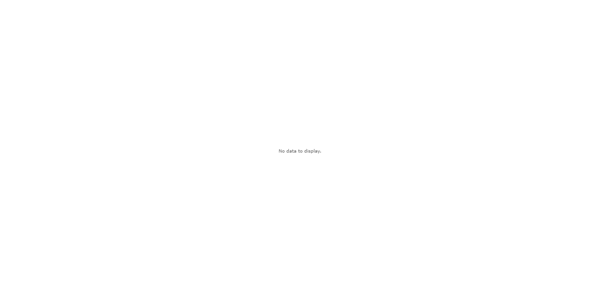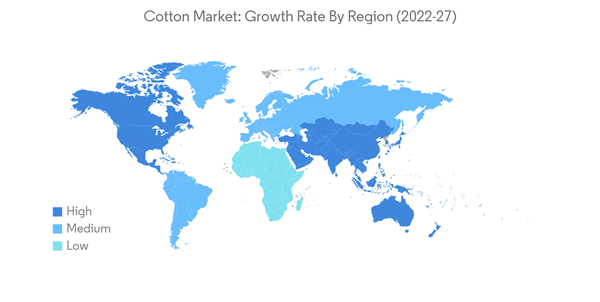The Cotton Market size is estimated at USD 43.96 billion in 2024, and is expected to reach USD 50.22 billion by 2029, growing at a CAGR of 2.70% during the forecast period (2024-2029).
This product will be delivered within 2 business days.
Key Highlights
- Cotton grows in nearly all tropical and subtropical regions worldwide and primarily supports the global textile mills and apparel manufacturing markets. The highly competitive prices of cotton fibers in the global market, coupled with the increasing export demand for cotton yarn and textile products, are expected to increase the global demand for cotton.
- For instance, according to the Reserve Bank of India, in the fiscal year 2022, the value of cotton and cotton products exported from India was over INR 1140 billion (USD 13.94 billion). This increased by almost INR 586 billion (USD 5.1 billion) compared to the previous financial year, which accounted for INR 726 billion (USD 8.8 billion). Also, a greater crop yield in Brazil, Australia, and Pakistan is predicted to increase global cotton production and consumption during the forecast period.
- Moreover, cotton is widely used to manufacture garments, apparel, and medical dressings. The abundance of natural fibers, especially cotton, in China, India, and the United States, is contributing significantly to the growth of the global textile market, which is expected to support the cotton market. For instance, according to METI, Japan, the consumption quantity of knitted fabrics made from cotton in the textile industry in Japan increased by 139.3 thousand kilograms (+6.96%) since the previous year (2021). In total, the consumption quantity amounted to 2.1 thousand tonnes in 2021. This huge demand for cotton from various sectors across the globe is expected to boost the market at a faster pace.
Cotton Market Trends
Increasing demand for the cotton exports
- The increasing applications and usage of cotton in various industries, including apparel manufacturing, home furnishings, and manufacturing of Industrial products, are driving the market's growth. Medical gauze, cotton swabs and rounds, and traditional diapers are all made using cotton. In addition, cottonseed oil is derived from cotton plants and can be used for cooking, soap making, or cosmetics.
- Owing to the increasing applications, the demand for cotton from many countries across the globe is increasing. For instance, according to the US Department of Agriculture (USDA), the United States was the leading exporter of cotton worldwide in 2021/2022. In that time period, the US cotton industry had an export volume of about 3.2 million metric tons. Brazil accounted for the second largest exporting share, with an export volume of 1.72 million metric tons, followed by India and Australia.
- Moreover, the United States plays a vital role in the global cotton market, acting as a key producer and exporter of fiber. The United States textile mills presently consume approximately 7.6 million bales of cotton annually. Eventually, about 57% of it is converted into apparel, more than a third into home furnishings, and the remainder into industrial products.
- Cotton's competitive share of US-produced textile end-uses shows a steady increase at approximately 34%. Hence, such increasing demand for cotton is eventually expected to raise exports during the forecast period.
Asia Pacific Dominates the Global Production
- Asia dominates global production. China leads the global production and export market, but most of the cotton produced is domestically consumed. Twenty-four of the 35 provinces of China grow cotton, with nearly 300 million people involved in its production.
- According to the US Department of Agriculture, in the crop year 2021/2022, cotton production in China amounted to around 5.88 million metric tons. India holds second place with 5.33 million metric tons of cotton production.
- Over the years, the region has achieved a significant quantitative increase in cotton production. According to the cotton corporation of India, India is one of the world's largest cotton producers, accounting for about 22% of the world's cotton production. The yield per kgs hectare, which is presently 469 kgs/ha, is still lower than the average export yield of about 787 Kgs/ha. Similarly, while the world's cotton production for 2021 accounted for 26.36 million metric tons, India alone accounted for about 5.79 million metric tons of cotton production.
- Moreover, the dominance of the textile sector prevails in both China and India, as it consumes most of the cotton produced in the country. Hence, such instances as a high requirement for cotton in major countries like India and China in Asia-Pacific are expected to drive the demand for increased cotton production in the same region during the forecast period.
Cotton Industry Overview
Additional Benefits:
- The market estimate (ME) sheet in Excel format
- 3 months of analyst support
This product will be delivered within 2 business days.
Table of Contents
1 INTRODUCTION
4 MARKET DYNAMICS
5 MARKET SEGMENTATION
Methodology

LOADING...










